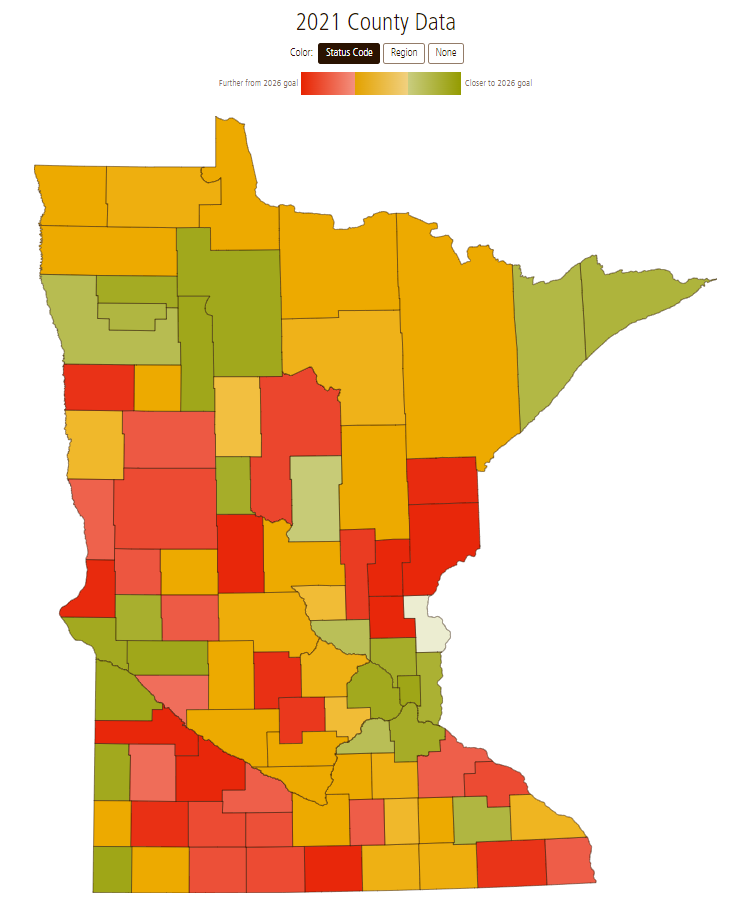 Image: Blog hero Plant Plate 09 boys dig in
Image: Blog hero Plant Plate 09 boys dig in
Gearing up for federal broadband funding? Your county profile can help

by Alie McInerney Posted in Broadband
Reposted from the Blandin on Broadband blog
By Ann Treacy, Treacy Information Services
Minnesota is looking at an unprecedented amount of money coming in (from State and Federal funds) to support deployment of better broadband. Today, policymakers and government agencies are processing how to spend that money but opportunity is around the corner. So what can your county do to prepare? Assess your current situation. We have the tools that can help:
- 2021 County Profiles (published in Oct 2021)
- Most recently ranking/assessment of broadband coverage (published in Dec 2021)
There are a couple of questions to help guide your assessment:
- How does your county compare?
- What are your roadblocks?
- Do you have a potential provider partner?
- Do you have community support?
How do you compare?
Legislators look at two numbers to measure broadband goals – the total number of households that need access and the maps that show which counties are coverages and which aren’t. They are looking for best deal for the dollar – generally homes that are spread apart of in difficult to reach terrain are more expensive to serve. Right now policymakers are wrangling with which of these goals to prioritize but you can at least know where you stand.
Check out the latest ranking/coverage charts. The top 44 ranking counties have 80 percent or better coverage; the bottom 11 ranking counties have less than 55 percent coverage. Where do you rank? What is your percentage of coverage? Check out your county profile, which includes a map. Do you have a lot of houses that need broadband? Are they close together or far apart from each other? What solution will get your residents the broadband they need and help the State reach it’s goals.
It’s also worth looking at how your county ranking has changed since the county profiles and the latest ranking. Some counties have really gained ground (McLeod and Brown) and some are losing ground (Le Sueur and Kandiyohi). Know that’s part of your narrative.
What are your roadblocks?
Knowing your roadblocks will help you build your team and/or create a strategy that will get your funded and served. Start with your county profile. Many profiles, if not most, will outline what roadblocks you might be experiencing. (You may want to look at previous profiles too to see if there are issues you have overcome or that may remain (2018, 2019 or 2020). Here are some common roadblocks or scenarios that might indicate an issue:
- You have a disinterested provider that covers much of your county. You may need to decide whether to work with that provider or find another.
- You lack competition from multiple providers. This may overlap with a disinterested provider and the answer may again be finding providers who are interested in serving the area.
- You invested years ago and are well served for 25 Mbps down and 3 up but not for 100/20. You may need to convince residents (or providers) that you need more for the future. This has become easier since the pandemic and more people stay at home for work and school.
- You are in an area that may receive federal funding (such as RDOF) but so far funds have not been awarded. Indications point to the possibility of State Funding in 2022.
Do you have a potential provider partner?
You may already know the providers in your area and county. If not, you can start with your county profile. See if there are providers that have received grants in the area; they are potential partners. See if there are other areas that serve the area. (If they profile doesn’t include providers, check the list of providers by county from the Office of Broadband Development. White you are there, you might check out list of providers in neighboring counties if you are looking for new partners. Also know that there are providers who are willing to go into new areas if you can persuade them that your area would be a good one to serve.
Do you have community support?
Once again, you can start with your county profile. Your profile will indicate if you’ve received any State broadband grants or worked with the Blandin Foundation and specific projects may be mentioned. You can also find your representatives; if you search their name on the Blandin on Broadband blog, you can see if they have been tracked talking about broadband. Community engagement isn’t important if you have a committed provider but if you don’t it can be an asset, especially when public funding may be required to deploy broadband. The community may need to commit financially or by communicating with policymakers.